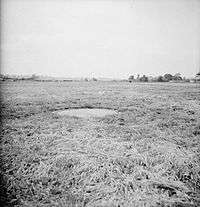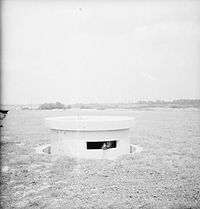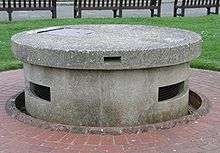Pickett-Hamilton fort
| Pickett-Hamilton fort | |
|---|---|
| Lashenden Air Warfare Museum | |
.gif) Pickett-Hamilton fort excavated and reconstructed above ground for public display[1] | |
| Type | Pillbox |
| Site history | |
| In use | Second World War |
| Materials | Concrete |
A Pickett-Hamilton fort is a type of hardened field fortification built in Britain during the invasion crisis of 1940–1941.[2] The Pickett-Hamilton fort was designed to be lowered into the ground while it was not in use, as such it would be inconspicuous and would not interfere with the passage of taxiing aircraft or other vehicles. The fort could be raised to about 2 feet 6 inches (0.76 m) above ground level where it would be a physical impediment to aircraft and vehicles and from where a small crew could fire with rifles or light machine guns.[3]
Development
– Pickett-Hamilton Fort Advisory Committee (1940)[4]
The open spaces of airfields were very vulnerable to attack by airborne troops and it was felt that it was particularly important to defend them effectively. However, conventional defences such as pillboxes and trenches could not be installed without danger to friendly aircraft. At this time a number of private companies contacted the government with their own design ideas.[lower-roman 1]
The Pickett-Hamilton fort was designed by Francis Norman Pickett and Donald St Aubyn Hamilton. Pickett (1887–1957)[6] was an engineer. He graduated from London University in 1907, and from 1918 to 1931 he was Proprietor of the firm of F. N. Pickett et Fils, engaged on the demolition of ammunition.[7] This business encountered many difficulties but Pickett made a great deal of money[8] before the company eventually failed.[9] Pickett spent much of the early '20s involved in motor racing.[10] He subsequently became Managing Director of Kaycee, Ltd., in 1931–35, of Consolidated Rubber Manufacturers, Ltd., in 1935–38, and of Ocean Salts (Products), Ltd., in 1938.[6] Hamilton (1907–1956) was an architect based in London.[11] Later, as part of Donald Hamilton, Wakeford & Partners, he designed many buildings in London and southern England.[3]
A friend of Norman Pickett, racing driver Donald Campbell, allowed his workshops to be used to build the prototypes.[12][13] In early 1940, Campbell attended the operational trials of the prototype at RAF Andover.[12][13]
Winston Churchill wrote to General Ismay on 12 July 1940 saying: "I saw these pillboxes for the first time when I visited Langley last week. This appears to afford an admirable means of anti-parachute defence and it should surely be widely adopted. Let me have a plan."[1] This pillbox was adopted by the Air Ministry and became known as the Pickett-Hamilton fort.[14]
Design


The most common version of the Pickett-Hamilton fort consists of two cylinders of pre-cast concrete each with one end closed. The slightly smaller of the two cylinders slides into the larger and they are kept apart by small guard rollers on the moving part that engaged with grooves.[3] The structure is buried so that the overhanging top of the smaller cylinder lies flush with the ground. Closed in this position the pillbox is inconspicuous and allows aircraft and other vehicles to safely drive straight over it.[3]
The interior is accessed via a small hatch and rungs built into the structure. To bring it into action a lifting mechanism was used to raise the inner cylinder by about 2 feet 6 inches (0.76 m) thereby revealing three embrasures. A crew of two men could then operate the fort as a pillbox.
Initially, the lifting mechanism consisted of a standard 8-ton aeroplane jack that took three minutes to raise the fort.[14] This was soon replaced with a pneumatic ram that was based on a system originally intended for agricultural use.[1][15] The pneumatic system operated with compressed air stored in cylinders: this allowed the fort to be raised and lowered quickly when speed was essential.[14] A hand pump was also provided to raise the fort for daily maintenance or as a backup method.[4]
An alternative design used counterbalance weights to raise the fort.[3] This allowed the fort to be raised by the physical strength of the garrison. This design had two access hatches and, with a slightly larger underground chamber and the elimination of the central pneumatic ram the fort could have a crew of four men.[4][16] Under consideration in late 1940, this alternative design was not used in significant numbers and only about a dozen were installed.[17]
The cost of construction was about £240[4] (equivalent to £12,000 in 2018[18]).
Extant examples

The forts were prone to flooding and they were not sufficiently strong to bear the weight of the heavy aircraft developed during the war.[14] Consequently, many forts were moved to the periphery of airfields and are not in their original location. More recently, some forts have been moved as airfields have been developed for modern aircraft. Records show that there were 335 installations.[14] Forty-eight examples of this type remain extant.[19]
A number of forts are displayed at Museums: Tangmere Military Aviation Museum,[12] Lashenden Air Warfare Museum,[1] D-Day Museum, Southsea (moved from its original location) and an inner part only at the Imperial War Museum Duxford.
Because they retract into the ground inconspicuously, many examples have been lost and rediscovered many years later.[13][20]
The management of Kent International Airport (formerly RAF Manston) donated a Pickett-Hamilton fort to Lashenden Air Warfare Museum. Although most of the surviving forts are flooded, the fort at Manston was dry and in superb condition.[1] The fort was excavated and restored to working order by museum members over a period of 18 months. Although the fort was originally intended to be buried on an airfield there was concern that putting it in the ground might, over time, degrade the concrete. Therefore, the fort has been placed at ground level and surrounded with a cone of earth and sandbags.[1] The lifting mechanism is in working order and can be activated by visitors putting a coin into a slot.[1] This is the only fully restored Pickett-Hamilton fort.
See also
References
Notes
- ↑ See Bison concrete armoured lorry for an alternative portable airfield defence scheme, put forward by Concrete Limited.[5]
References
- 1 2 3 4 5 6 7 Pickett-Hamilton fort, Lashenden Air Warfare Museum.
- ↑ Wills 1985, p. 20.
- 1 2 3 4 5 Pickett & Hamilton 1940.
- 1 2 3 4 WO 199/2527.
- ↑ "Concrete Armoured Vehicles". Wheels & Tracks. Battle of Britain Prints International (41): 42–44. 1992.
- 1 2 Grace's Guide obituary.
- ↑ Poverty Bay Herald 1 July 1920.
- ↑ Zanders, pp. 201–206.
- ↑ Times 19 October 1932.
- ↑ Counting the Akelas.
- ↑ Belling-Lee Radio Factory.
- 1 2 3 Pickett-Hamilton fort, Tangmere Military Aviation Museum.
- 1 2 3 Disappearing pillbox, BBC News.
- 1 2 3 4 5 Francis.
- ↑ Goldup 1938.
- ↑ Pickett Hamilton Pillbox Worthy Down, Derelict Places.
- ↑ World War II Pickett-Hamilton Fort, Worthy Down Airfield.
- ↑ UK Retail Price Index inflation figures are based on data from Clark, Gregory (2017). "The Annual RPI and Average Earnings for Britain, 1209 to Present (New Series)". MeasuringWorth. Retrieved November 6, 2017.
- ↑ Ruddy 2003, p. 21, Pickett_Hamilton Fort.
- ↑ Hidden WWII secrets, North Norfolk News.
Bibliography
- Foot, William (2006). Beaches, fields, streets, and hills ... the anti-invasion landscapes of England, 1940. Council for British Archaeology. ISBN 1-902771-53-2.
- Francis, Paul. "Pickett-Hamilton Fort". Pillbox study group. Retrieved 21 September 2016.
- Osborne, Mike (2004). Defending Britain ... twentieth century military structures in the landscape. Tempus Publishing. ISBN 0-7524-3134-X.
- Ruddy, Austin (2003). British Anti-Invasion Defences 1940–1945. Official Handbook of the Pillbox Study Group. Historic Military Press. ISBN 1-901313-20-4.
- Wills, Henry (1985). Pillboxes: A Study of UK Defences. Leo Cooper. ISBN 0-436-57360-1.
- "Pickett-Hamilton fort". Thesaurus. English Heritage. Retrieved 21 September 2016.
- "The Pickett Hamilton Fort". Tangmere Military Aviation Museum. Retrieved 21 September 2016.
- "Rare war-time 'disappearing pillbox' found at Evanton". BBC News. 17 December 2013. Retrieved 21 September 2016.
- "Pickett Hamilton Fort". Lashenden Air Warfare Museum. Retrieved 21 September 2016.
- "Hidden WWII secrets unearthed at RAF Coltishall". North Norfolk News. Retrieved 21 September 2016.
- "A Rare Find". uk.rec.subterranea. Retrieved 21 September 2016.
- "Francis Norman Pickett (obituary)". Grace's Guide. Retrieved 23 September 2016.
- "Manure From TNT". Poverty Bay Herald. 1 July 1920. Retrieved 23 September 2016.
- "Mr. F. N. Pickett's Failure". The Times. London, England. 19 October 1932. p. 16 column e.
- "Counting the Akelas". Motor Sport: 64. March 1997.
- Zanders, Jean Pascal. "The destruction of old chemical munitions in Belgium" (PDF). The Trench. Retrieved 23 September 2016.
- Goldup, Cecil Edgar (26 August 1938). "Improvements relating to the raising and lowering of agricultural implements". Espacenet. Retrieved 26 September 2016.
- Pickett, Francis Norman; Hamilton, Donald St Aubyn (12 July 1940). "An improved means for the protection of aerodromes, aircraft landing fields and other situations (patent)". Espacenet. Retrieved 23 September 2016.
- "World War II Pickett-Hamilton Fort SU 4681 3512 (NO.1), Worthy Down Airfield". Historic England. Retrieved 28 September 2016.
- "Pickett Hamilton Pillbox Worthy Down". Derelict Places. Retrieved 28 September 2016.
- "WO 199/2527 – Pillboxes". The Catalogue. The National Archives. November 1940.
External links
| Wikimedia Commons has media related to Pickett-Hamilton Retractable Fort. |
- "Homepage". UK: The National Archives. Retrieved 2 August 2010.